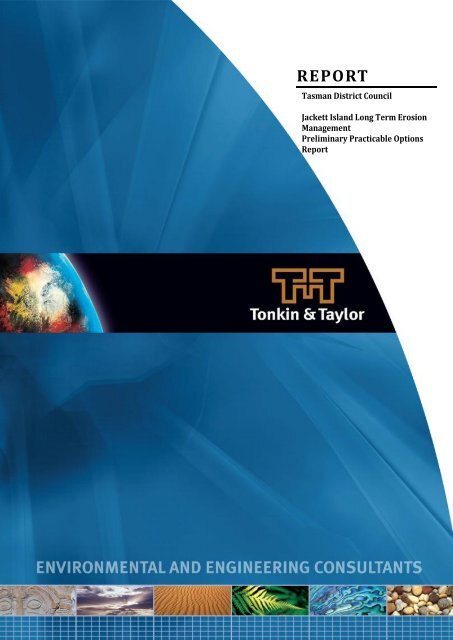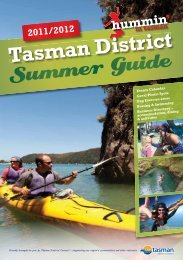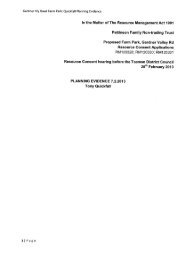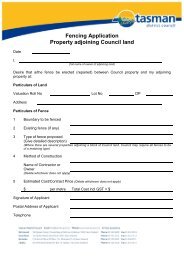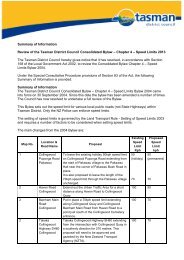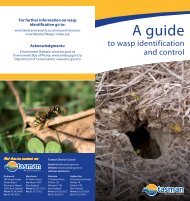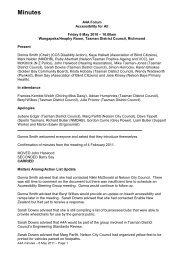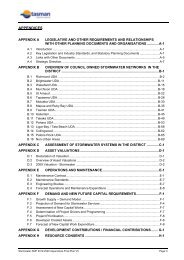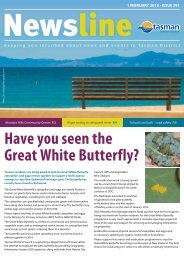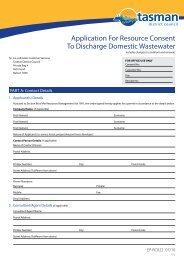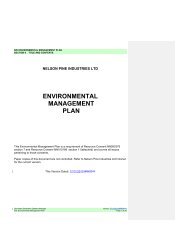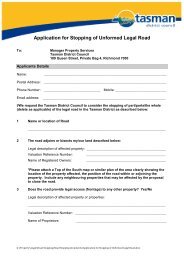RESC11-12-02 Port Motueka Groyne-Jackett Island Erosion ...
RESC11-12-02 Port Motueka Groyne-Jackett Island Erosion ...
RESC11-12-02 Port Motueka Groyne-Jackett Island Erosion ...
You also want an ePaper? Increase the reach of your titles
YUMPU automatically turns print PDFs into web optimized ePapers that Google loves.
REPORT<br />
Tasman District Council<br />
<strong>Jackett</strong> <strong>Island</strong> Long Term <strong>Erosion</strong><br />
Management<br />
Preliminary Practicable Options<br />
Report
REPORT<br />
Tasman District Council<br />
<strong>Jackett</strong> <strong>Island</strong> Long Term <strong>Erosion</strong><br />
Management<br />
Preliminary Practicable Options<br />
Report<br />
Report prepared for:<br />
Tasman District Council<br />
Report prepared by:<br />
Tonkin & Taylor Ltd<br />
Distribution:<br />
Tasman District Council<br />
Tonkin & Taylor Ltd (FILE)<br />
1 copy (electronic)<br />
1 copy<br />
November 2011<br />
T&T Ref: 27882-PPO-R2
Table of contents<br />
1 Introduction 1<br />
1.1 Current progress 1<br />
2 The current understanding of coastal processes 2<br />
3 Potential solutions 4<br />
3.1 Do nothing 4<br />
3.2 Asset relocation 4<br />
3.3 Planning responses 5<br />
3.4 Existing channel maintenance 5<br />
3.5 New small channel dredging (PMUG Option) 6<br />
3.6 Reset of channel position 7<br />
3.7 Training <strong>Groyne</strong>s with nourishment from existing channel maintenance 8<br />
3.8 Seawall (land protection) 8<br />
3.9 Alternative options 8<br />
3.10 Summary 9<br />
4 Applicability 10<br />
Appendix A: Changes to the Spit from 1993 to 2011<br />
Appendix B:<br />
Sketches of potential solutions<br />
<strong>Jackett</strong> <strong>Island</strong> Long Term <strong>Erosion</strong> Management Preliminary Practicable Options Report Job no. 27882-PPO-R2<br />
Tasman District Council November 2011
Executive summary<br />
This report sets out the preliminary assessment of practicable options to manage the<br />
erosion experienced along the seaward edge of <strong>Jackett</strong> <strong>Island</strong> to achieve the following<br />
objectives:<br />
1. Reduce risk of erosion hazard affecting human life and physical assets<br />
2. Restore the shoreline position to approximate the year 2000 shoreline<br />
3. Provide a solution that considers the seaward edge of the <strong>Jackett</strong> <strong>Island</strong> shoreline for a<br />
period of 35 years (i.e. long term = 35 years), the maximum duration possible for a<br />
coastal permit.<br />
4. Legitimise or remove existing groyne from the Coastal Marine Area.<br />
Action is currently being progressed on Item 4.<br />
The key erosion processes affecting <strong>Jackett</strong> <strong>Island</strong> are due to the following processes:<br />
<br />
<br />
<br />
<br />
Focussing of wave energy over the intertidal and sub-tidal terminal lobe of the<br />
<strong>Motueka</strong> Spit, which is presently adjacent to central <strong>Jackett</strong>’s <strong>Island</strong>, leading to locally<br />
increased wave heights (erosion adjacent to the seaward (distal) tip of the spit has<br />
previously been observed and reported as the spit grew southward between breach<br />
cycles);<br />
Sand eroded from the beach (across-shore due to the short-period waves) is then<br />
removed from the site by the tidal current that run parallel to the beach;<br />
Due to the relatively close proximity of the distal tip of the spit to <strong>Jackett</strong> <strong>Island</strong>, the<br />
strong tidal currents of the main channel are forced closer to <strong>Jackett</strong> <strong>Island</strong> further<br />
exacerbating the erosion in this area, and;<br />
Loss of sediment supply to <strong>Jackett</strong> <strong>Island</strong> due to the presence of the main tidal<br />
channel between the spit and the <strong>Island</strong>. The sediment supply to <strong>Jackett</strong> <strong>Island</strong> was<br />
previously from the spit, with the biggest influxes occurring following breaching of<br />
the spit, with the remnant spit south of the new channel formed by the breach<br />
migrating shoreward to <strong>Jackett</strong> <strong>Island</strong>.<br />
Considering the general options and approach as set out in Policy 27 of the New Zealand<br />
Coastal Policy Statement, the following options to provide erosion protection to <strong>Jackett</strong><br />
<strong>Island</strong> provide a range of approaches consistent with the policy were considered:<br />
<br />
<br />
<br />
<br />
<br />
<br />
<br />
<br />
Do nothing<br />
Asset relocation<br />
Planning responses<br />
Channel maintenance<br />
New small channel dredging<br />
Channel reset<br />
Channel maintenance and training groynes<br />
Seawalls.<br />
All long term physical work options have significant cost and impact on the physical<br />
environment. Options that maintain the channel (existing channel maintenance and the<br />
new small channel dredging) have increased benefit to the wider community through<br />
improving access to the <strong>Port</strong>. However, sand transfer and small scale channel improvement<br />
<strong>Jackett</strong> <strong>Island</strong> Long Term <strong>Erosion</strong> Management Preliminary Practicable Options Report<br />
T&T Ref. 27882-PPO-R2<br />
Tasman District Council November 2011
options also have the greatest risk of failing to meet the required objectives unless ongoing<br />
maintenance is included. Therefore these options have a greater ongoing cost. Hard<br />
protections works have a high cost and high risk in terms of gaining consent approval. The<br />
reset option has a significant initial effect, but provides an option that could have no<br />
ongoing maintenance costs.<br />
Asset relocation and/or planning responses should be considered as part of any long term<br />
plan for this area.<br />
<strong>Jackett</strong> <strong>Island</strong> Long Term <strong>Erosion</strong> Management Preliminary Practicable Options Report T&T Ref. 27882-PPO-R2<br />
Tasman District Council November 2011
1<br />
1 Introduction<br />
This report sets out the preliminary assessment of practicable options to manage the erosion<br />
experienced along the seaward edge of <strong>Jackett</strong> <strong>Island</strong>. The following objectives were agreed in<br />
mediation between Richard Reinen-Hamill (T&T) and Shaw Mead (ASR) to form the basis of any<br />
long term resolution of the erosion issue at <strong>Jackett</strong> <strong>Island</strong>:<br />
1. Reduce risk of erosion hazard affecting human life and physical assets<br />
2. Restore the shoreline position to approximate the year 2000 shoreline<br />
3. Provide a solution that considers the seaward edge of the <strong>Jackett</strong> <strong>Island</strong> shoreline for a period<br />
of 35 years (i.e. long term = 35 years), the maximum duration possible for a coastal permit.<br />
4. Legitimise or remove existing groyne from the Coastal Marine Area.<br />
1.1 Current progress<br />
Consents are currently being sought for the removal of the existing groyne (addressing Item 4<br />
above). The removal of the existing groyne along the <strong>Motueka</strong> Spit is unlikely to result in the<br />
restoration of spit breaching process, as other processes such as sand build up and vegetation are<br />
now acting at this location. However, removal of those portions of the groyne that currently<br />
extend into the Coastal Marine Area may have localised effects on alongshore sediment transport<br />
and sheltering of the southern (distal) end of the spit. This option is proposed rather than full<br />
groyne removal or reconsenting of the existing structure. Ongoing monitoring would be required<br />
and exposed areas of groyne removed as it becomes exposed.<br />
<strong>Jackett</strong> <strong>Island</strong> Long Term <strong>Erosion</strong> Management Preliminary Practicable Options Report<br />
T&T Ref. 27882-PPO-R2<br />
Tasman District Council November 2011
2<br />
2 The current understanding of coastal processes<br />
Kirk (1990) 1 provides the most comprehensive description available of the coastal processes of<br />
the <strong>Motueka</strong> Spit/Moutere Inlet/<strong>Jackett</strong>’s <strong>Island</strong> complex. This report presents the results of a<br />
technical investigation into the causes and nature of bar sedimentation, prior to groyne<br />
construction (1996) and considers methods of controlling infilling of the navigation channel. In<br />
summary:<br />
<br />
<br />
<br />
<br />
<br />
<br />
<br />
An offshore bar that is the submarine extension of <strong>Motueka</strong> Spit lies 400-500 m offshore<br />
and is nourished by sand transported south-eastward along the spit by waves and wavedriven<br />
currents;<br />
Offsetting of the channel (south-easterly propagation) and infilling develops over several<br />
years. Periodically the bar was breached nearer the <strong>Port</strong> by floods from the Moutere Inlet<br />
that augment the tidal compartment. An interval of generally improved navigation then<br />
ensued before offsetting again occurs. Kirk estimated realignment occurred naturally every<br />
10-15 years.<br />
The offshore bar is controlled by longshore drifts of sand from the <strong>Motueka</strong> River under<br />
wave action and is periodically relieved by major freshwater flood from the Moutere River.<br />
Estimated net sand transport occurs from northwest to southeast in the ratio 3.6:1 and the<br />
best estimate of transport under dominant northerly waves is 47,500 m 3 /year.<br />
Wave action drives alongshore sediment transport southeast down the spit. This amount<br />
approximates the average sediment supply from the <strong>Motueka</strong> River each year (64,000 m 3 ).<br />
Severe ongoing erosion of the mainland shore northwest of <strong>Port</strong> <strong>Motueka</strong> is considered to<br />
be due to spit capturing the longshore sand supply that once nourished this shore.<br />
One of the 5 control options suggested was a groyne or offshore breakwater to deflect<br />
southward transported sand and potentially stabilize the channel if located at the<br />
northwest distal (seaward) tip of the spit. However, Kirk recommended dredging as the<br />
best method of maintenance of the channel entrance.<br />
A 700 m long groyne was constructed in 1996. Environment Court has determined that the<br />
consequences of construction of the groyne, which is more accurately described as a<br />
breakwater/seawall (depending on the elevation of a particular part of the structure), due to its’<br />
orientation largely parallel to wave crest orientation, has contributed to:<br />
<br />
<br />
<br />
<br />
Lengthening, widening and heightening of the spit to dimensions and at a rate not recorded<br />
since 1881;<br />
‘Plugging’ of the area that usually breached in the past with a 700 m non-erodible structure;<br />
Interrupting of the estimated 10-15 year breaching cycle (the spit has not breached since<br />
the groyne was constructed 16 years ago and is now considered too wide and high to<br />
readily breach at present), and;<br />
Aggressive erosion of <strong>Jackett</strong> <strong>Island</strong>.<br />
1 Kirk, R. M., 1990. Coastal Sedimentation and Navigability at <strong>Port</strong> <strong>Motueka</strong>, Moutere Inlet.<br />
Report to Tasman District Council. July 1990<br />
<strong>Jackett</strong> <strong>Island</strong> Long Term <strong>Erosion</strong> Management Preliminary Practicable Options Report<br />
T&T Ref. 27882-PPO-R2<br />
Tasman District Council November 2011
3<br />
The aggressive erosion of central <strong>Jackett</strong> <strong>Island</strong> is due to the following processes:<br />
<br />
<br />
<br />
<br />
Focussing of wave energy over the intertidal and sub-tidal terminal lobe of the <strong>Motueka</strong><br />
Spit, which is presently adjacent to central <strong>Jackett</strong>’s <strong>Island</strong>, leading to locally increased<br />
wave heights (erosion adjacent to the seaward (distal) tip of the spit has previously been<br />
observed and reported as the spit grew southward between breach cycles);<br />
Sand eroded from the beach (across-shore due to the short-period waves) is then removed<br />
from the site by the tidal current that run parallel to the beach;<br />
Due to the relatively close proximity of the distal tip of the spit to <strong>Jackett</strong> <strong>Island</strong>, the strong<br />
tidal currents of the main channel are forced closer to <strong>Jackett</strong> <strong>Island</strong> further exacerbating<br />
the erosion is this area, and;<br />
Loss of sediment supply to <strong>Jackett</strong> <strong>Island</strong> due to the presence of the main tidal channel<br />
between the spit and the <strong>Island</strong>. The sediment supply to <strong>Jackett</strong> <strong>Island</strong> was previously from<br />
the spit, with the biggest influxes occurring following breaching of the spit, with the<br />
remnant spit south of the new channel formed by the breach migrating shoreward to<br />
<strong>Jackett</strong> <strong>Island</strong>.<br />
<strong>Erosion</strong> rates of central <strong>Jackett</strong> <strong>Island</strong> have been up to 4 m/year since 2000.<br />
The recent migration of the spit has been further assessed using a combination of historic<br />
bathymetric surveys and more recent LIDAR surveys. Data from 1993, 1997, 2001, 2008 and 2011<br />
were available for analysis. Figures 1 to 5 in Appendix A show the progression of various contours<br />
ranging from 2 m above Nelson Vertical Datum datum to 2 m below Nelson Vertical Datum (i.e.<br />
the 4.2 m, 3.2 m, 2.2 m (approx Mean Sea Level), 1.2 m and 0.2 m level). LIDAR data was not<br />
available for the lower levels (i.e. 0.2 m contour) and we note that 2011 hydrographic survey data<br />
is not yet available.<br />
Figures 1 to 5 show that the spit has been extending at around 60 to 80 m/yr since 1993 (some<br />
<strong>12</strong>00 m) and the focus of erosion along <strong>Jackett</strong> <strong>Island</strong> is also moving to the south, currently<br />
affecting some 800 m of shoreline based on the comparison of the 2.2 m and 4.2 m contour lines<br />
measured in 2008 and 2011.<br />
Figure 4 shows the low tide line has moved significantly landward in the vicinity of the Van Dyke<br />
Property from 1997 to 2008 with as much as <strong>12</strong>0 m landward movement, although this level has<br />
not changed significantly from 2008 to 2011. However, erosion of the upper shoreline has<br />
continued to occur along the central beach area, with associated accretion to the north.<br />
<strong>Jackett</strong> <strong>Island</strong> Long Term <strong>Erosion</strong> Management Preliminary Practicable Options Report<br />
T&T Ref. 27882-PPO-R2<br />
Tasman District Council November 2011
4<br />
3 Potential solutions<br />
Considering the general options and approach as set out in Policy 27 of the New Zealand Coastal<br />
Policy Statement, the following options to provide erosion protection to <strong>Jackett</strong> <strong>Island</strong> provide a<br />
range of approaches consistent with the policy. An outline of each approach and potential issues<br />
are identified.<br />
3.1 Do nothing<br />
The do nothing option is assuming no additional works are carried out apart from the progressive<br />
removal of the existing groyne. We would expect the spit to continue to extend and shoreline at<br />
<strong>Jackett</strong> <strong>Island</strong> to continue to retreat. Based on the changes between 2008 and 2011 the volume<br />
of loss along the beach face is estimated at around 6,000 to 8,000 m 3 /yr along the 800 m of<br />
shoreline affected by erosion in this time period.<br />
The future trend and behaviour of the spit is difficult to determine. However, it is likely that the<br />
ongoing southerly growth of the spit would continue at least in the short term. If the same rate<br />
occurs as recently experienced the spit will reach the southern end of <strong>Jackett</strong> <strong>Island</strong> in 10 to 15<br />
years. This progression is likely to increase erosion pressures at the southern end of the <strong>Island</strong> as<br />
well as to Kina, although the sheltering effect may limit storm induced erosion.<br />
As the northern end of the spit appears to be getting thinner, the source of sand and spit growth<br />
appears to be as much from transfer of sand along the spit as well as sand transported from the<br />
<strong>Motueka</strong> River delta. As the spit continues to extend southward it is possible that a breach may<br />
occur in the spit and the outlet change position. If this does occur it is likely that this would be<br />
within the spit area to the south of the existing groyne.<br />
The implication of spit development on <strong>Jackett</strong> <strong>Island</strong> is that erosion is likely to continue as there<br />
is a reduction in sand supply from the spit as the bypass is occurring further to the south and<br />
there will be ongoing channel induced erosion as the spit forces the outlet channel closer to the<br />
island. Therefore the area of most risk extends from the central area of <strong>Jackett</strong> <strong>Island</strong> to the<br />
southern end of the island. It is also possible that Kina peninsula may also be affected by the<br />
change in bypassing as some point in the future.<br />
The do nothing option does not meet the requirements of the Environment Court decision and<br />
would only be an option should all other options not be practicable.<br />
3.2 Asset relocation<br />
Removing the dwellings further landward to remove assets from risk is a form of risk reduction.<br />
The issues associated with landward relocation of private assets on <strong>Jackett</strong> <strong>Island</strong> includes the low<br />
lying nature of the land, with some parts of the island being only slightly higher than Mean High<br />
Water Springs. So relocation to remove the physical asset at risk from erosion would need to be<br />
done in conjunction with raising land levels in the vicinity of the proposed building platform. This<br />
option would need the support of those land owners affected, or alternative options (such as<br />
property purchase, relocation and then resale or removal) would need to be considered.<br />
Unless this option included private property purchase and removal or relocation, this option in<br />
isolation does not address the loss of private land area or meet the requirements of the<br />
Environment Court decision and would only be an option should all other options not be<br />
practicable.<br />
<strong>Jackett</strong> <strong>Island</strong> Long Term <strong>Erosion</strong> Management Preliminary Practicable Options Report<br />
T&T Ref. 27882-PPO-R2<br />
Tasman District Council November 2011
3.3 Planning responses<br />
This may include establishment of hazard lines and development of planning policies within the<br />
District Plan to reduce increasing risk of hazards as done in many parts of New Zealand (e.g.<br />
Canterbury, Hawke’s Bay and Bay of Plenty). Such policies have included prohibition of new<br />
development within extreme hazard areas and preventing inter-generational passing on of land.<br />
The planning responses need to recognise the timing needed to achieve this which may require<br />
the implementation of engineering or structural solutions in the short to medium term. This<br />
option may have merit for future development but does not address the existing properties that<br />
have status and existing use rights.<br />
This option is recommended as a parallel process with other physical works options to provide a<br />
consistent approach in managing coastal hazards. However, this option does not address the loss<br />
of private land area or meet the requirements of the Environment Court decision.<br />
3.4 Existing channel maintenance<br />
This option involves regular mechanical bypassing of sand from the distal end of the spit to <strong>Jackett</strong><br />
<strong>Island</strong>, replicating the natural process affected by the original groyne. A conceptual sketch of this<br />
option is shown on Figure 6 (Appendix B). The works would involve an initial capital dredge of the<br />
landward side of the spit and transfer of this sand along the seaward edge of <strong>Jackett</strong> <strong>Island</strong> to<br />
realign the existing channel further seaward from its current position. It is estimated that around<br />
110,000 m 3 of sand (possible range from 80,000 m 3 to 140,000 m 3 ) would need to be placed along<br />
the foreshore of <strong>Jackett</strong> <strong>Island</strong> to restore the shoreline to the 2000 shoreline position. The lower<br />
bound assessment of volume was based on an 800 m length of shoreline affected with a profile<br />
height of 4 m and an average shoreline retreat of 2.3 m per year for the last 11 years with the<br />
potential upper bound based on 4 m/year erosion, that was the upper rate of annual shoreline<br />
change recorded along the Van Dyke property in the centre of the island.<br />
After the initial placement, regular transfer of sand would be required to maintain the channel<br />
position away from <strong>Jackett</strong> <strong>Island</strong> and to maintain the beach position. The rate of sand loss along<br />
<strong>Jackett</strong> <strong>Island</strong> is estimated to be around 10,000 m 3 /yr (lower and upper bound range is 7,400<br />
m 3 /yr and <strong>12</strong>,800 m 3 /yr respectively) which is less that the longshore drift rate of 47,500 m 3 /yr<br />
estimated to occur along the spit.<br />
This work could be done by a cutter suction dredge with a slurry pump discharging the dredged<br />
sand to the <strong>Jackett</strong> <strong>Island</strong> shoreline. Initial costing of dredging is based on indicative costs of sand<br />
dredging of $10/m 3 presented by OCEL for the <strong>Motueka</strong> <strong>Port</strong> Users Ltd 2 that included mobilization<br />
costs, but not for contingencies, engineering and environmental costs (design/contract<br />
supervision/monitoring etc) and also not for the costs of placement and shaping of sand along the<br />
<strong>Jackett</strong> <strong>Island</strong> shoreline. We have included additional cost for P&G (10%), sand shaping and<br />
management along <strong>Jackett</strong> <strong>Island</strong> of $6/m 3 , 20% contingency and 30% for engineering and<br />
environmental management. Based on this approach the preliminary estimates of initial cost for<br />
this option is in the order of $2.0M to $3.0M.<br />
Annual maintenance costs assuming a similar distribution of costs but with a smaller volume could<br />
range between $200,000 and $330,000 per annum.<br />
5<br />
2 OCEL (2011). Establishing and maintaining a new navigation channel for <strong>Port</strong> <strong>Motueka</strong> (Draft).<br />
Unpublished report for <strong>Motueka</strong> <strong>Port</strong> Users Ltd. May 2011.<br />
<strong>Jackett</strong> <strong>Island</strong> Long Term <strong>Erosion</strong> Management Preliminary Practicable Options Report<br />
T&T Ref. 27882-PPO-R2<br />
Tasman District Council November 2011
6<br />
This option would effectively maintain the existing situation in terms of channel orientation and<br />
improve the erosion situation along <strong>Jackett</strong> <strong>Island</strong> through active management. It also has the<br />
benefit of limiting dredging within the more sensitive ecological areas of the spit. However, it<br />
would not result in the potential for the natural system to be restored and would need ongoing<br />
maintenance and monitoring costs unless alternative land management options were brought in<br />
over time that reduced the need for ongoing maintenance works.<br />
3.5 New small channel dredging (PMUG Option)<br />
This option is discussed in the draft report prepared by OCEL for the <strong>Port</strong> <strong>Motueka</strong> User Group<br />
(PMUG). The objective is to dredge a channel across the spit, based on the recommendation by<br />
Kirk (1991) to provide improved access to the port. The proposal as illustrated in Figure 7 and<br />
involves a channel 50 m wide set at 3 m below Nelson Vertical Datum (or approximately Mean<br />
Sea Level). They estimated some 132,500 m 3 of sand would need to be moved to form this<br />
channel and they identified that the existing channel would need to be closed off. OCEL proposed<br />
an extension of the gravel berm to the end of the existing training wall would be sufficient in<br />
combination with the flows from the inlet through the new opening being sufficient to reinforce<br />
the new channel position and that full closure of the existing channel would not be required.<br />
Sedimentation rates of between 14,250 and 23,750 m 3 /yr were estimated by OCEL based on work<br />
done by Kirk (1991).<br />
While not identified in the OCEL plan, their draft report identified that the material dredged for<br />
formation of the channel and ongoing maintenance could be used to replenish the foreshore of<br />
<strong>Jackett</strong> <strong>Island</strong>. This would be done by a cutter suction dredge with a slurry pump discharging to<br />
an area in the lee of the existing training groyne and then the sand transferred by truck to place<br />
along the <strong>Jackett</strong> <strong>Island</strong> shoreline.<br />
We note the proposal does not cut off the existing channel and there is a risk that flows both from<br />
the inlet and the area to the north between the mainland and the spit may divert back into the<br />
existing channel should the new channel block or be less hydraulically efficient than the existing<br />
channel. The likelihood of this occurring would require additional assessment and modelling.<br />
Initial costing of dredging is based on indicative costs of sand dredging of $10/m 3 presented by<br />
OCEL for the <strong>Motueka</strong> <strong>Port</strong> Users Ltd included mobilization costs, but not any allowance for<br />
contingencies, engineering and environmental costs (design/contract supervision/monitoring etc)<br />
and also not for the costs of placement and shaping of sand along the <strong>Jackett</strong> <strong>Island</strong> shoreline.<br />
Therefore, OCEL’s cost estimate of $1.4M is unlikely to cover the actual costs of the proposed<br />
activities required to maintain the coastal edge along <strong>Jackett</strong> <strong>Island</strong>.<br />
To provide a comparative costing assessment with our channel maintenance option we have<br />
included additional cost for P&G (10%), sand shaping and management along <strong>Jackett</strong> <strong>Island</strong> of<br />
$8/m 3 , 20% contingency and 30% for engineering and environmental management. The sand<br />
transfer is higher than the previous option as there is a longer haul required to move sand in this<br />
option. We have assumed <strong>12</strong>0,000 m 3 is transferred to the shoreline along <strong>Jackett</strong> <strong>Island</strong>. Based<br />
on this approach the preliminary estimates of initial cost of the PMUG option is in the order of<br />
$3.7M.<br />
Annual maintenance costs including the transfer of a portion of the sand to <strong>Jackett</strong> <strong>Island</strong> could<br />
range between $200,000 and $330,000 per annum. However, if the new channel functioned as<br />
desired, then there may be less need to transfer sand to <strong>Jackett</strong> <strong>Island</strong> and the by-passing would<br />
involve transfer of sand to a location down drift (south) of the new channel.<br />
This option would work towards restoring the situation at the spit that existed prior to the<br />
geotextile groyne being constructed and would also provide a mechanism to manage erosion<br />
<strong>Jackett</strong> <strong>Island</strong> Long Term <strong>Erosion</strong> Management Preliminary Practicable Options Report<br />
T&T Ref. 27882-PPO-R2<br />
Tasman District Council November 2011
7<br />
along <strong>Jackett</strong> <strong>Island</strong>. It has a wider benefit than just for the management of erosion to <strong>Jackett</strong><br />
<strong>Island</strong> residents.<br />
Maintaining the flows through this channel location would result in the southern spit migrating<br />
towards land as the hydraulic control from the existing channel flow would not be present. This is<br />
likely to result in the southerly migration of the channel unless maintenance works were carried<br />
out to maintain the channel position in the original location.<br />
There are risks associated with not addressing the closure of the existing channel that would need<br />
to be further assessed. This option also needs ongoing maintenance and monitoring both for the<br />
channel opening and the erosion along <strong>Jackett</strong> <strong>Island</strong>.<br />
3.6 Reset of channel position<br />
This option has the principle objective in setting up the system to a position where the spit<br />
dynamics could operate with no further human interference. This differs from the PMUG option<br />
in that there is no further maintenance works proposed. The reset option requires forming a<br />
major dredged channel through the <strong>Motueka</strong> Spit with the volume sufficient to provide a closure<br />
bund to the existing channel and to restore the <strong>Jackett</strong> <strong>Island</strong> shoreline to the 2000 position. The<br />
channel would need to be hydraulically efficient and the bund of sufficient volume to minimise<br />
the risk of the flows breaching and returning to the existing channel. This concept is shown in<br />
Figure 8. With this option, there is no ongoing maintenance proposed as the natural system<br />
would be replicated as far as possible, with nature dictating the ongoing development and<br />
movement of the channel, spit and bars. It is expected that over time the channel will drift to the<br />
south, moved by the southerly longshore drift and that the breach-and-channel-reset mechanism<br />
will operate as-and-when nature dictates.<br />
There are currently no accurate estimates of volumes of this option as there is no hydrographic<br />
survey data available or studies done to assess the volume of material required to form the bund.<br />
However, assuming a similar order of sand is required as is to be placed along <strong>Jackett</strong> <strong>Island</strong> (say<br />
110,000 m 3 ), the total volume required to be dredged is around 220,000 m 3 . Assuming a 50 m<br />
wide bund with 8:1 side slopes and a crest level of 2 m above MSL and the average base around<br />
Chart Datum, the volumes required to form the bund could be up to 200,000 m 3 . Therefore the<br />
upper bound of material required to be dredged could be in the order of 310,000 m 3 . It is noted<br />
that this bund could be seen as a reclamation, even though the intention would be to allow<br />
nature to take its course and over time the bund could erode or its position be modified by<br />
natural processes.<br />
The sand to form the bund and to use for restoring <strong>Jackett</strong> <strong>Island</strong> would need to be double<br />
handled, similar to the PMUG option. A rate of $10/m 3 has been assumed for the initial dredging<br />
and an additional $10/m 3 for the formation of the bund and transfer to <strong>Jackett</strong> <strong>Island</strong>, reflecting<br />
the potentially greater costs required to form the bund. Contingencies for this option have also<br />
increased to 50% for the lower bound and 30% for the upper bound volumes reflecting the lack of<br />
current lack of certainty on this option. Indicative costs for the reset option range from $8.3M to<br />
$10.5M.<br />
This is a significant option, with both dredging and forming of a reclamation (the bund). The<br />
works extend through the existing spit, affecting the existing values and attributes of the spit.<br />
This would create extensive consenting issues that would need to be worked through. However,<br />
as a one off “reset” with no further works/maintenance proposed, might reduce effects that<br />
ongoing maintenance works would create. There may be less direct benefit to the port<br />
community for this option, unless they continue with the maintenance dredging regime.<br />
<strong>Jackett</strong> <strong>Island</strong> Long Term <strong>Erosion</strong> Management Preliminary Practicable Options Report<br />
T&T Ref. 27882-PPO-R2<br />
Tasman District Council November 2011
8<br />
3.7 Training <strong>Groyne</strong>s with nourishment from existing<br />
channel maintenance<br />
This option is an extension of the existing channel maintenance option. In this instance the<br />
placed sediment would be stabilized by the construction of channel training groynes. These<br />
groynes would extend along the seaward edge of <strong>Jackett</strong> <strong>Island</strong> to move the tidal currents away<br />
from the existing shoreline. The issue with these type of structures is that they can transfer<br />
erosion effects down drift as sediment is locked up by the structures. This means that they will<br />
need to extend along the seaward edge of <strong>Jackett</strong> <strong>Island</strong> and most likely extend along Kina<br />
Peninsula. Figure 9 shows an indication of the typical configuration, with 250 m long groynes<br />
along the majority of the <strong>Jackett</strong> <strong>Island</strong> shoreline at 500 m centres, with the length reducing<br />
towards the southern end and Kina to enable a transition to natural shores. We note that these<br />
are indicative only and would need further analysis and testing.<br />
The groynes could be constructed using a similar construction methodology to the existing<br />
training groyne (concrete panels and steel) or from rock armour. Costing of these structures has<br />
been done assuming a rock armour structure 4 m high with 1.5:1 side slopes and a crest width of<br />
2.5 m and a rock armour costing of $90/m 3 based on recent rock revetment works at Ruby Bay.<br />
An additional allowance of 10% of the rock costs has been included for geotextile and associated<br />
works. This equates to a linear metre cost of around $3,350 for a rock groyne. We note<br />
alternative structures may be lower cost, but have used this rate to provide an initial estimate of<br />
costs. The total length of groynes shown on Figure 9 is around 1,680 m.<br />
The costs for these works using a similar allowance for P&G, contingency and engineering and<br />
environmental design as the channel maintenance option results in a cost of around $<strong>12</strong>M for this<br />
option. It is anticipated that ongoing maintenance costs would be low, but may still be in the<br />
order of $50,000 to $100,000 per annum.<br />
There are significant issues that will need to be addressed with this option, including the potential<br />
risks to the down drift (northern) coastline. Extensive studies and assessments would be<br />
required. The structures would also create significant visual impacts and be problematic with<br />
regard to gaining consent.<br />
3.8 Seawall (land protection)<br />
This would be a substantial structure, occupying the existing upper beach extending around the<br />
majority of the island’s perimeter. The structure would have a similar appearance to the seawalls<br />
recently constructed at Ruby Bay. They would create issues of access and visual amenity and may<br />
also result in down drift erosion effects as they would reduce the volume of sand transferred to<br />
the south.<br />
Based on the Ruby Bay seawall rock costs and taking into account the more challenging access<br />
location, a rock revetment would cost in the order of $2,000 to $3,000 per linear metres and<br />
would need to extend along some 2000 m of shoreline. Costs for this option, excluding access<br />
ways, etc would be in the order of $6M to $10M.<br />
There are significant issues that will need to be addressed with this option, including the potential<br />
risks to the down drift (northern) coastline. Extensive studies and assessments would be<br />
required. The structures would also create significant visual impacts and be problematic with<br />
regard to gaining consent.<br />
3.9 Alternative options<br />
It is possible to place sand from another source along the <strong>Jackett</strong> <strong>Island</strong> shoreline. However, this<br />
option does not adequately address the causes of erosion. Without modifying the channel<br />
<strong>Jackett</strong> <strong>Island</strong> Long Term <strong>Erosion</strong> Management Preliminary Practicable Options Report<br />
T&T Ref. 27882-PPO-R2<br />
Tasman District Council November 2011
9<br />
location the rates of erosion that could occur would be significant and would create a larger<br />
requirement for ongoing maintenance. The cost of imported sand and transportation would also<br />
be significant. Sand haulage for the recently constructed sand bag wall along the Van Dyke<br />
property was around $28/m 3 . This did not include the cost for the sand. The processed sand used<br />
for the Oriental Bay beach nourishment that was brought to site by barge cost the order of<br />
$90/m 3 . Therefore costs in range of $60/m 3 to $100/m 3 for imported sand is possible. This is a 6<br />
to 10 fold increase in the local sand source rate.<br />
There are alternative locations for a dredged channel through the spit than those shown for the<br />
options presented in this report. However, the success of a successful channel breach is that it<br />
provides a preferable alternative for the flows leaving and entering the inlet and that it provides<br />
sufficient sand volume to restore the seaward edge of <strong>Jackett</strong> <strong>Island</strong>. Without some form of bund<br />
to prevent flows re-establishing along the existing channel there is a risk that these options will<br />
not be successful in the long term.<br />
3.10 Summary<br />
All long term physical work options have significant cost and impact on the physical environment.<br />
Options that maintain the channel (existing channel maintenance and the new small channel<br />
dredging) have increased benefit to the wider community through improving access to the <strong>Port</strong>.<br />
However, sand transfer and small scale channel improvement options also have the greatest risk<br />
of failing to meet the required objectives unless ongoing maintenance is included. Therefore<br />
these options have a greater ongoing cost. Hard protections works have a high cost and high risk<br />
in terms of gaining consent approval. The reset option has a significant initial effect, but provides<br />
an option that could have no ongoing maintenance costs.<br />
Asset relocation and/or planning responses should be considered as part of any long term plan for<br />
this area.<br />
<strong>Jackett</strong> <strong>Island</strong> Long Term <strong>Erosion</strong> Management Preliminary Practicable Options Report<br />
T&T Ref. 27882-PPO-R2<br />
Tasman District Council November 2011
Appendix A: Changes to the Spit from 1993 to 2011
Appendix B:<br />
Sketches of potential solutions


